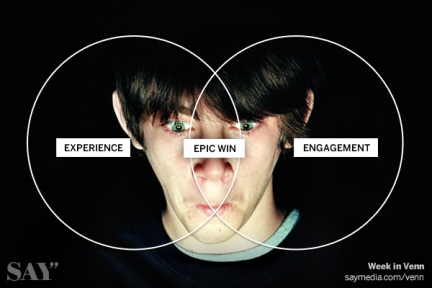Game On: The Rules of Online Ad Engagement - Say Media

If you're wondering what engages people consider this: Globally, there are now 1 billion people on the planet who play games for at least an hour a day. And that number is climbing fast with the growing adoption of smartphones and tablets. In fact, Jane McGonigal, director of game research at the Institute for the Future argues in her wildly popular TED talk, we should spend more time playing games too. Games like World of Warcraft give players the opportunity to save worlds, and the incentive to learn the habits of heroes – as well as solve big real-world problems.
Gamification, the process of applying the best elements of gaming to real-world, non-game situations, is also incredibly effective at creating behavioural change. A classic example is Volkswagen's Fun Theory experiment from 2009. By turning a set of subway stairs into piano keys, researchers were able to encourage 66 percent more people to use the stairs over the escalator. More recently and relevantly to digital media, a new Gigya study of billions of user actions with partners like Pepsi, Nike, and Dell, showed that adding gamification to a site boosts engagement by almost a third.
It's no wonder then that brands have been quick to consider game mechanics to solve an advertising challenge: increasing ad engagement. And it hasn't been just the usual suspects like Pepsi and McDonald's who are trying it either. In 2011, Clarins launched a Facebook game aimed at women which involved managing a successful beauty salon and Aldo created the brilliant Aldo Shoe Paradise. But brands can play games in more places than just Facebook. 2013 was the year that gamification went big in social media and Superbowl ads , proof positive that this is no passing fad.
This appetite for gaming creates greater scope for brands in all their online advertising. Videos in banner ads used to be novel, now they're standard practice. Where brands can really drive user engagement is by getting consumers to play. When consumers become players, they are by definition more engaged. And that's where the money is.
But as with any type of content marketing, there are rules of engagement:
Rule #1: Find the right game fit. Games make great content, but only if they make sense in context. A game that lets you shoot aliens doesn't quite work for a beauty brand, but a guessing game does. Clinique's online campaign to promote its new Chubby Stick Moisturizing Lip Colour Balm required players to rotate a candy jar and count the number of Chubby Sticks buried inside. The art direction fit completely with the Clinique brand, and the candy theme was linked to a 'sweet treats' promotion taking place in Clinique's online store.
Rule #2: Use a carrot when you want something in exchange. Sometimes games can be used to persuade your audience to enter into a data transaction, like this recent example from Sony Xperia which required players to register personal data to gain access to the game. Just make sure it's worth their while on the other side.
Rule #3: Familiarity breeds content. Matching a brand to a game doesn't always mean creating something from scratch. For this Virgin Media campaign, a simple button-bashing game reminiscent of the famous Track & Field arcade staple, engages the audience and communicates the brand message of speed perfectly.
Rule #4: Create an experience - and make it social. Gamification is a natural meeting point for experiential and digital marketing, like this impressive driving competition from BMW. But as far as branded games, one ofthe finest of recent times has to be the Face which was well-made, scalable, shareable and rewarded repeated plays. Was it gimmicky? Of course it was, but it was also a fun and memorable experience for the millions who played (and shared) it.
Slapping a game into an ad isn't automatically going to deliver results, nor should marketers include games in ads just for the hell of it to boost engagement. But it is a useful tool in the arsenal. And if you want consumers to take the time to play your brand game, you have a responsibility to deliver a meaningful experience – just like you do with any other piece of content, whether it's sponsored or not.
Carla Faria is Solutions Director for Say Media UK.
[Image Credit: Faces of Gamers, Phillip Toledano]
Say Media is a digital publishing company that creates amazing media brands. Through its technology platform and media services, Say enables its portfolio of independent content creators to build passionate communities around key consumer interest areas such as Style, Living, Food and Tech. For more information visit www.saymedia.com.
Read all Say Media's MediaBizBloggers commentaries at Say Daily.
Check us out on Facebook at MediaBizBloggers.com
Follow our Twitter updates @MediaBizBlogger
The opinions and points of view expressed in this commentary are exclusively the views of the author and do not necessarily represent the views of MediaBizBloggers.com management or associated bloggers. MediaBizBloggers is an open thought leadership platform and readers may share their comments and opinions in response to all commentaries.

